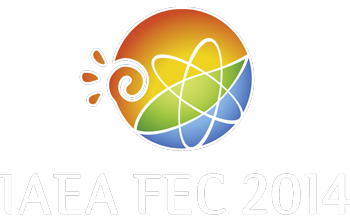Speaker
Dr
Lionello Marrelli
(Italy)
Description
Disruptions caused by tearing modes (TM) are considered to be one of the most critical roadblocks to achieving safe steady state operation of tokamak fusion reactors. Here, a new scheme to avoid such disruptions is proposed by utilizing the electro-magnetic (EM) torque produced with 3D coils that are available in many present tokamaks. In this scheme, the EM torque to the modes is created by a toroidal phase shift between the externally-applied field and the excited TM fields, compensating the mode momentum loss due to the interaction with the resistive wall and error field. Fine control of torque balance is provided by a feedback scheme. Experimentally, we have explored this in DIII-D, a non-circular divertor configuration with 3D coils inside the wall, and made comparisons to the performance in RFX-mod (operated as a tokamak), a circular limiter device with active feedback coils outside the wall using a slightly different, independently developed technique.
In high beta poloidal discharges in DIII-D, by applying sufficiently high gain, a large amplitude m/n=2/1 TM propagating initially with the plasma rotation was successfully slowed down in a controlled manner to very low frequency, i.e. of the order of the inverse of resistive wall time τ_w, and sustained over several seconds. Upon termination of feedback, the mode became locked leading to disruption. The controllability of torque balance was illustrated by rotating the mode forward or backward with varying feedback phase shift. In RFX-mod the controllability of mode rotation has been demonstrated at moderate plasma density (n/n_G<0.5 where n_G is the Greenwald limit) and low q(a) [q(a)<2.5], using pure real gains with no added phase shift. Here the key element for sustaining a mode at slow rotation frequency, ~ 1/τ_w, is the minimization of coil-sideband pollution. Theoretical models developed independently for both devices showed that experiment observations are consistent with common understanding.
The achievements in both devices showed that this approach is robust, suggesting that the application to ITER would expand the horizon of its operational regime. The 3D coils currently under consideration for ELM suppression would be well suited to this purpose.
This work was supported by the US Department of Energy under DE-AC02-09CH11466, DE-FC02-04ER54609, DE-FG02-08ER85195, and DE-FG02-04ER54761.
| Country or International Organisation | USA |
|---|---|
| Paper Number | EX/P2-42 |
Author
Dr
Michio Okabayashi
(Princeton Plasma Physics Laboratory)
Co-authors
Mr
A. M. Garofalo
(General Atomics)
Dr
Chiara Piron
(Consorzio RFX)
Dr
Diasuke Shiraki
(Oak Ridge National Laboratory)
Dr
Edward J. Strait
(General Atomics)
Prof.
Francesco A. Volpe
(Columbia University)
Dr
Jeremy Hanson
(Columbia University)
Dr
Lidia Piron
(Consorzio RFX)
Dr
Lionello Marrelli
(Italy)
Dr
P. Zanca
(Consorzio RFX)
Dr
Paolo Piovesan
(Consorzio RFX)
Prof.
Piero MARTIN
(Consorzio RFX)
Dr
Rob La Haye
(General Atomics)
Dr
Yongkyoon In
(FAR-TECH, Inc.)

